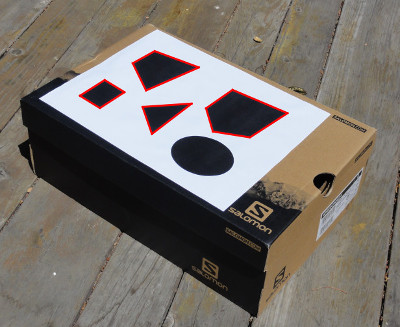Example Detect Black Polygons
From BoofCV
Revision as of 05:43, 16 September 2015 by Peter (talk | contribs) (Created page with " center|border|Red lines outline detected polygons. Was configured to find objects with 3 to 5 sides. As of v0.19, a single class is at...")
As of v0.19, a single class is at the core of all fiducial detection in BoofCV, BinaryPolygonConvexDetector. What it does is detects black polygons inside the image and then refines that estimate to within subpixel precision. It does this quickly, robustly, and very accurately. At least for squares. For other shapes it is usable but not as bullet proof, but that is likely to improve in the future.
Example Code:
Concepts:
- Polygons
- Fiducials
Relevant Applets:
Related Examples
Example Code
/**
* Example of how to use {@link BinaryPolygonConvexDetector} to find black polygons in an image. This algorithm
* is the basis for several fiducial detectors in BoofCV and fits the polygon to sub-pixel accuracy and produces
* reasonable results on blurred images too. It is highly configurable and can even sparsely fit polygons
* in a distorted image. Meaning the expensive step of undistorting the entire image is not needed.
*
* @author Peter Abeles
*/
public class ExampleDetectBlackPolygon {
public static void main(String[] args) {
String files[] = new String[]{
"../data/applet/polygons01.jpg",
"../data/applet/shapes02.png",
"../data/applet/fiducial/image/examples/image01.jpg"};
ConfigPolygonDetector config = new ConfigPolygonDetector(3,4,5,7);
// Tighten the tolerance for what defines a line
config.contour2Poly_splitDistanceFraction = 0.02;
BinaryPolygonConvexDetector<ImageUInt8> detector = FactoryShapeDetector.polygon(config, ImageUInt8.class);
// Is the input image distorted? Let the detector sparsely undistort it for improved speed and accuracy
// detector.setLensDistortion(...blah...);
ListDisplayPanel panel = new ListDisplayPanel();
for( String fileName : files ) {
BufferedImage image = UtilImageIO.loadImage(fileName);
ImageUInt8 input = ConvertBufferedImage.convertFromSingle(image, null, ImageUInt8.class);
ImageUInt8 binary = new ImageUInt8(input.width,input.height);
// Binarization is done outside to allows creative tricks. For example, when applied to a chessboard
// pattern where square touch each other, the binary image is eroded first so that they don't touch.
// The squares are expanded automatically during the subpixel optimization step.
int threshold = GThresholdImageOps.computeOtsu(input,0,255);
ThresholdImageOps.threshold(input, binary, threshold, true);
// it takes in a grey scale image and binary image
// the binary image is used to do a crude polygon fit, then the grey image is used to refine the lines
// using a sub-pixel algorithm
detector.process(input, binary);
// visualize results by drawing red polygons
FastQueue<Polygon2D_F64> found = detector.getFound();
Graphics2D g2 = image.createGraphics();
g2.setColor(Color.RED);
g2.setStroke(new BasicStroke(3));
for (int i = 0; i < found.size; i++) {
VisualizeShapes.drawPolygon(found.get(i),true,g2,true);
}
panel.addImage(image,new File(fileName).getName());
}
ShowImages.showWindow(panel,"Found Convex Polygons with 3, 4,5, and 7 sides",true);
}
}
